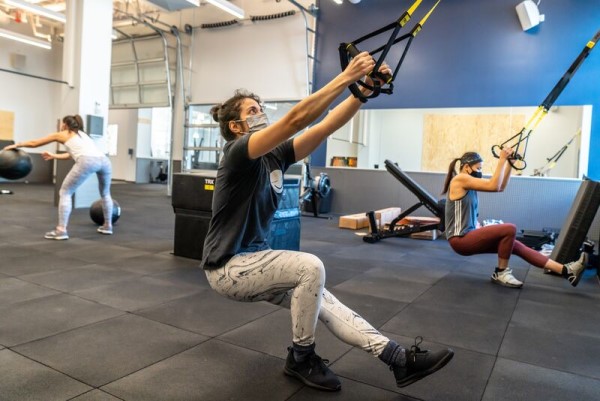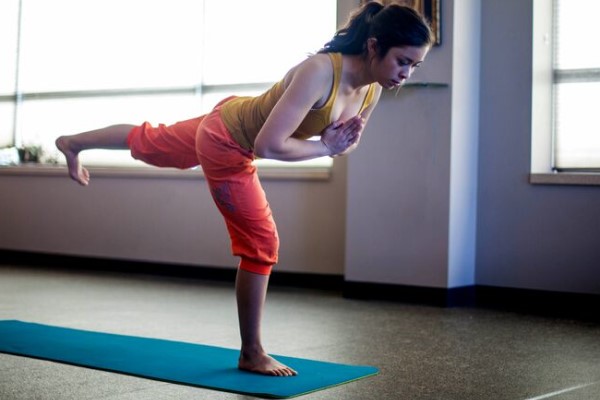build leg strength (and climb stronger) with pistol squats
A pistol squat is an exercise that is very easy to explain, but hard for most people to do. From a standing position, shift your weight to one leg while the other leg shoots forward. From there, you squat down, bringing your tailbone to your heel and then stand up from a seated or squat position, again only using one leg.
Pistol squats are great for increasing leg strength and improving balance, which means they really give you a leg up in your climbing.
why are pistol squats so hard?
Before we get into the pistol squat progression, let's talk a bit about why you'll likely need to work up to a pistol squat: it's a challenging exercise. The difficulty of a pistol squat boils down to three things: strength, flexibility, and balance. You need all three in order to do a proper one.
The single biggest factor you'll need in order to use a single leg to lift your body into a standing position is strength. Flexibility and mobility in your ankle will help you fully bring your tailbone down to your foot without your heel coming off the ground. Finally, balance is very important because your center of gravity is now on one foot instead of two, which means you must shift your weight in order to not fall over.
pistol squat benefits and why they will improve your climbing

First of all, having individual leg strength is incredibly helpful when you're on an overhung wall and you need to use your leg strength to push off a foot hold and stick a move. In that situation, you're exploding off of one foot while dynamically moving toward the next hand hold.
Pistol squat training will also be really helpful on more vertical and slab climbs. How many times have you placed your foot high and didn't have the leg strength to shift your weight up onto your foot and stand up? I promise that building single-leg strength, flexibility, and balance will make slab climbing a piece of cake.
pistol squat progression
One thing to know about pistol squats: the majority of people cannot do an unassisted pistol squat on their first try.
But never fear! That is why I created a pistol squat progression that will build the strength, flexibility, and balance you need to do an unassisted pistol squat. It may take some time, but try not to get discouraged, and keep trying. I promise you'll get there!
progression exercise 1: assisted pistol squats
%20051022.jpg?width=600&name=MOVEMENT%20Blog_Pistol%20Squats_Progression%201%20Englewood_Carissa%20Gross%20(2)%20051022.jpg)
The key to getting to successfully executing a pistol squat is to start with some assistance, which will help you keep balance, work on the flexibility of the ankle, and gain the strength needed. After some time, you'll get stronger and will need less assistance.
Head to the gym and look for one of the following: a stretch-resistant band, a TRX trainer, a bar, or a buddy. Grab whatever tool you're using with both hands and slowly lower yourself on one leg into a squat.
Make sure you are keeping your entire foot and heel on the ground. Don't let the rest of your body touch the ground. Once you find the balance to sit in the position for 3 seconds, you need to push the standing heel into the ground hard and try and stand up on that one leg. Make sure you are trying to stand up first, and then pull yourself the rest of the way up by using the TRX, band, bar, or buddy.
Repeat this move 6-8 times before switching your legs for a full set. Do 2-3 sets per leg with a 3-5 minute rest between sets.
As you build strength, try using only one hand to assist in standing up on your squatting leg.
progression exercise 2: pistol squat on a bench
Find a bench or stool that is mid-calf height. Stand in front of it and, with both feet on the ground, sit down on the stool/bench.
Bring one leg up in front of you while keeping the other foot on the ground and stand up. Once fully stood up put both legs on the ground and sit back down, and repeat. This exercise will specifically train you to stand up on one leg just like you would on the climbing wall.
Repeat this move 10-12 times before switching legs for a full set. Do 2-3 sets per leg with a 3-5 minute rest between sets.
As you build strength, try finding a stool/bench or something else that is closer to the ground. You can also hold a 5-10lb weight in your hand to help build more strength.
progression exercise 3: work your flexibility and balance
It may take you a couple of months (or longer) of regular practice to master the exercises. At this point, you probably feel ready to go for a full pistol squat, but you may find that you fall on your attempts. What gives?
Most commonly, the issue is ankle mobility and flexibility and the solution is to stretch your ankles.
There are plenty of exercises to help with this, but I recommend standing heel lifts, which involve starting in a standing position, raising your heels off the ground, and standing on your toes.

Another exercise would be single-leg balancing. This is great for pistol squats because it helps you train your balance on one leg as well! Stand with both legs on the ground and slowly lift one leg up in the air in front of you and hold your balance for 60 seconds.
progression exercise 4: pistol squats!
%20051022.jpg?width=600&name=MOVEMENT%20Blog_Pistol%20Squats_Progression%203_Hampden_Jeremy%20Kinney%20(3)%20051022.jpg)
Once you obtain the strength, flexibility, and balance, you should be ready to complete a full unassisted pistol squat. Do 4-6 reps per leg before switching legs for a full sett. Do 2-3 sets per leg with a 3-5 minute rest between sets.
When that becomes too easy, add difficulty by holding weight.
Congratulations--you are now among the elite climbers who can successfully do a pistol squat! Go find the slabby route you've likely been avoiding and give it a try!
Come climb with us! Find a Movement Gym near you.
Aaron Neal is a fitness instructor at our Dallas the Hill location. For more fitness tips and classes from Aaron, check out the fitness calendar at your local gym.

